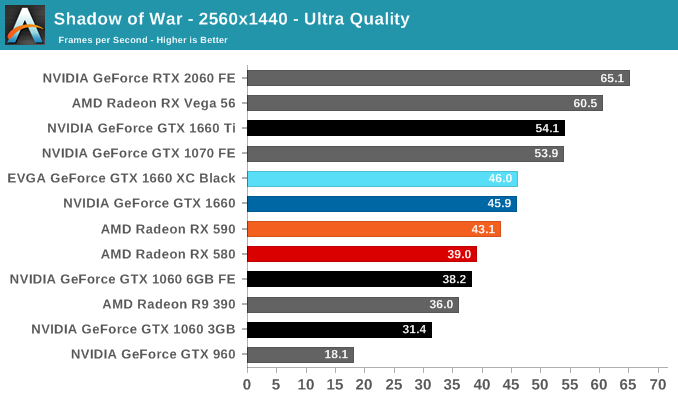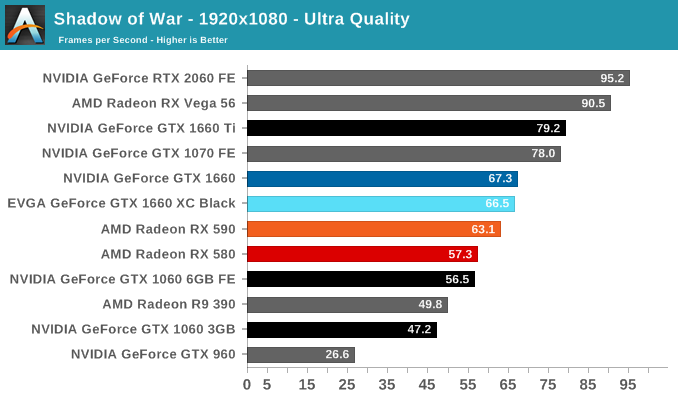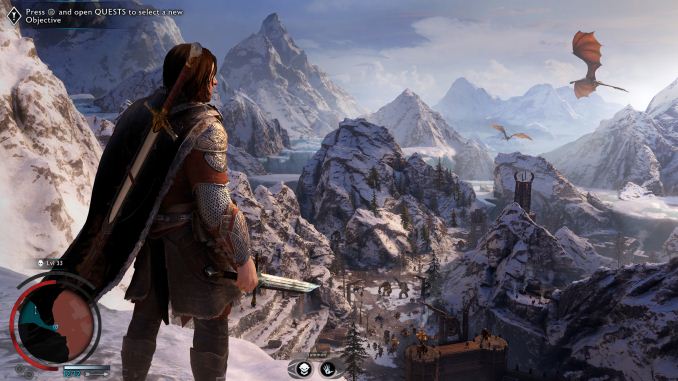The NVIDIA GeForce GTX 1660 Review, Feat. EVGA XC GAMING: Turing Stakes Its Claim at $219
by Ryan Smith & Nate Oh on March 14, 2019 9:01 AM ESTMiddle-earth: Shadow of War (DX11)
Next up is Middle-earth: Shadow of War, the sequel to Shadow of Mordor. Developed by Monolith, whose last hit was arguably F.E.A.R., Shadow of Mordor returned them to the spotlight with an innovative NPC rival generation and interaction system called the Nemesis System, along with a storyline based on J.R.R. Tolkien's legendarium, and making it work on a highly modified engine that originally powered F.E.A.R. in 2005.
Using the new LithTech Firebird engine, Shadow of War improves on the detail and complexity, and with free add-on high resolution texture packs, offers itself as a good example of getting the most graphics out of an engine that may not be bleeding edge. Shadow of War also supports HDR (HDR10).
We've updated some of the benchmark automation and data processing steps, so results may vary at the 1080p mark compared to previous data.


The GTX 1060 3GB starts to lag behind in this game, where the GTX 1660 takes a substantial lead. In turn, the GTX 1660 is solidly above the GTX 1060 6GB, along with the RX 580.











77 Comments
View All Comments
Qasar - Sunday, March 17, 2019 - link
ebay is not really an answer, as some.. may not want to deal with the hassle of ebay, or even have an ebay account. and now a days, not all games can be resold. but that still doesnt add any " value " to the video card by adding specific games...romrunning - Thursday, March 14, 2019 - link
Triple-slot coolers pretty much kill it for mini-ITX systems. Usually they only have room for double-slot at most.damianrobertjones - Thursday, March 14, 2019 - link
Second hand 1070 all... day... long.TheCurve - Thursday, March 14, 2019 - link
Great review guys, loved it!Tilmitt - Thursday, March 14, 2019 - link
If you actually want these reviews to be useful to real people making actual upgrade decisions, you need to include far more older GPUs. All the mid and high end GPUs from the 700 and 900 series at least. Preferably an awful lot more than this.Ryan Smith - Thursday, March 14, 2019 - link
It's always a fine balance between including older cards for context, and newer cards to showcase how it actually compares to other things you can buy (and the product it directly replaces). In this case we do have the GTX 960 and the R9 390 in these graphs; meanwhile for everything else, Bench can give you whatever comparisons you're looking for.https://www.anandtech.com/bench/GPU18/2293
Tilmitt - Friday, March 15, 2019 - link
Unless I'm doing it wrong, bench is useless because the cards people want to compare aresegregated into different bench years so you can't actually compare them. How does one compare a 770 and a 1660?
Ryan Smith - Friday, March 15, 2019 - link
Fair enough point on the Kepler cards. We haven't gone in and backfilled those yet. However all of the 900 series cards are in there.Hrel - Tuesday, March 19, 2019 - link
Doesn't seem to be any way to compare the R9 280x to the 1660 either, or the GTX1070.zeroidea - Monday, March 18, 2019 - link
If all the benchmark data is in a database, might it be possible to make the charts dynamic, and have an "add card to this graph" option? Better yet, store a user's personal system (or import it from pcpartpicker) and do this automatically for logged-in users, since this is what a lot of people care about (and currently open multiple tabs to different websites in order to accomplish the same thing). That's the kind of value-add that'd get me to cough up a bit for a premium membership, if AT ever wanted to go down that route.